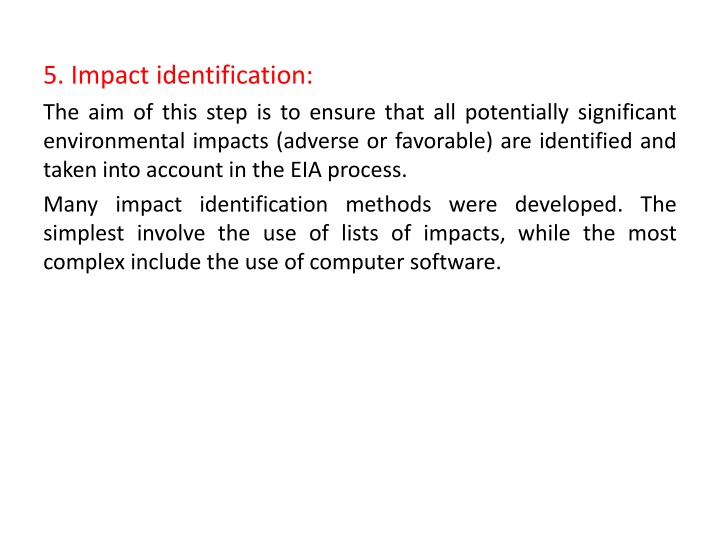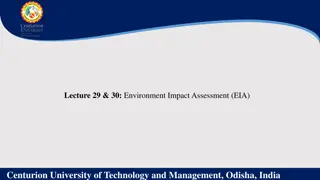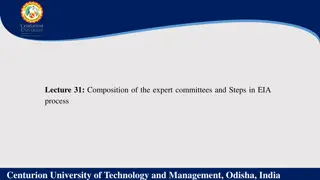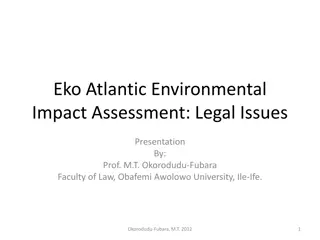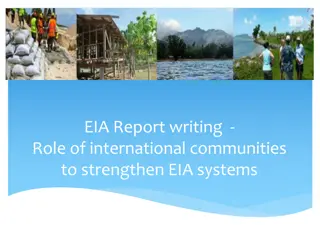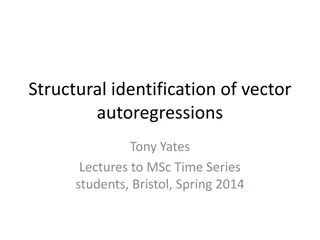Impact Identification Methods in EIA Process
This step ensures all potential environmental impacts are identified in the EIA process, using methods like checklists and matrices. Checklists involve factors like effects on human beings, buildings, and land, while matrices present impacts in a tabular form for better understanding and assessment of magnitude over time.
Download Presentation

Please find below an Image/Link to download the presentation.
The content on the website is provided AS IS for your information and personal use only. It may not be sold, licensed, or shared on other websites without obtaining consent from the author.If you encounter any issues during the download, it is possible that the publisher has removed the file from their server.
You are allowed to download the files provided on this website for personal or commercial use, subject to the condition that they are used lawfully. All files are the property of their respective owners.
The content on the website is provided AS IS for your information and personal use only. It may not be sold, licensed, or shared on other websites without obtaining consent from the author.
E N D
Presentation Transcript
5. Impact identification: The aim of this step is to ensure that all potentially significant environmental impacts (adverse or favorable) are identified and taken into account in the EIA process. Many impact identification methods were developed. The simplest involve the use of lists of impacts, while the most complex include the use of computer software.
The methods are divided into the following categories: checklists matrices networks overlay maps.
Checklists: Most checklists are based on a list of special environmental, social and economic factors that may be affected by a development. An example of check list is shown below: Effects on human beings, buildings and man-made features Change in population arising from the development, and consequential environment effects. Visual effects of the development on the surrounding area and landscape. Levels and effects of emissions from the development during normal operation. Levels and effects of noise from the development. Effects of the development on local roads and transport. Effects of the development on buildings, the architectural and historic heritage, archaeological features, e.g. through pollutants, visual intrusion, vibration.
Effects on flora, fauna and geology Loss of plant and animal species. Damage to geological features. Other ecological consequences. Effects on land Effects of chemical emissions and deposits on soil of site and surrounding land. Physical effects such as change in local topography, soil erosion, etc. quality and quantity of agricultural land to be taken.
other alternative uses of the site. Effect on surrounding land uses including agriculture. Effects on water Effects of development on drainage pattern in the area. Changes to other hydrographic characteristics, e.g. groundwater level, watercourses, flow of underground water. Effects of pollutants, waste, etc. on water quality. Effects on air and climate Level and concentration of chemical emissions and their environmental effects. Offensive odours. Other indirect and secondary effects associated with the project Effects of other development associated with the project, e.g. new roads, sewers, housing, power lines, pipelines, telecommunications, etc.
Matrices: Matrices are the most commonly used method of impact identification in EIA. Simple matrices are simply two dimensional tables showing environmental components on one axis and development actions on the other. The time-dependent matrix includes a number sequence to represent the timescale of the impacts (e.g. one number per year). where magnitude is represented by numbers from 0 (none) to 4 (high). Magnitude matrices go beyond the mere identification of impacts by describing them according to their estimated magnitude and importance.
Networks Network methods explicitly recognize that environmental systems consist of a complex web of relationships, and try to reproduce that web. Impact identification using networks involves following the effects of development through changes in the environmental parameters. Overlay maps A base map is prepared, showing the general area within which the project may be located. Successive transparent overlay maps are then prepared for the environmental components that, in the opinion of experts, are likely to be affected by the project (e.g. agriculture, woodland, noise). The composite impact of the project is found by the overlay maps and noting the relative intensity of the total shading. Unshaded areas are those where a development project would not have a significant impact
